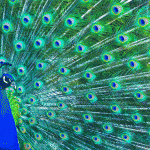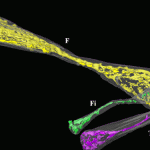
T. rex's jaw muscles and teeth would have made it a very successful predator. Image: Shutterstock
Scientists have examined T. rex’s dangerous dentures and powerful bite.
One of the first things you notice about Tyrannosaurus rex is the impressive array of teeth. Most people have just focused on the varying sizes, but University of Alberta palaeontologist Miriam Reichel has now discovered there is also considerable variation in the serrated edges of the teeth.
In her study, published in The Canadian Journal of Earth Science, Reichel concludes that the front teeth were designed for gripping and pulling, while the teeth along the side of the jaw would have punctured and torn flesh. The teeth at the back of T. rex’s mouth would have sliced and diced food and forced it to the back of the throat.
Reichel also analysed the teeth of the entire tyrannosaurid family of meat eating dinosaurs and found T. rex had the greatest variation in tooth morphology or structure. This dental specialisation, combined with its powerful jaws, would have made it a very successful predator.
And those jaws may have been more powerful than scientists previously thought. Researchers from the University of Liverpool and the University of Manchester, UK, have suggested that T. rex had the most powerful bite of any living or extinct terrestrial animal.
“The power of the T. rex jaw has been a much debated topic over the years,” Dr Karl Bates, University of Liverpool, said. “Scientists only have the skeleton to work with, as muscle does not survive with the fossil, so we often have to rely on statistical analysis or qualitative comparisons to living animals, which differ greatly in size and shape from the giant enigmatic dinosaurs like T. rex.“
The researchers artificially scaled the skulls of a human, an alligator, an Allosaurus and a juvenile T. rex to the size of an adult T. rex. In each case the bite forces increased, but not to the level of an adult T. rex, which would have a bite force of 8,000 to 13,400 Newtons, according to previous studies.
However, given the animal’s size (6,000 kilograms) researchers suspect that its bite may have been even more powerful. The bite force is determined by the jaw muscles, so the researchers developed a computer model to reverse engineer T. rex’s bite.
They tested a range of alternative muscle values, as it is not precisely known what dinosaur muscles were like. According to the study, published in Biology Letters, the computer models showed that T. rex had a more powerful bite than previously suggested, with predictions ranging from 20,000 to 57,000 Newtons.
The study also revealed that the juvenile T. rex had a weaker bite force than an adult, suggesting that it may have undergone a change in feeding behaviour as it grew.
— Laura Boness.
Source: Eureka Alert T. Rex’s killer smile revealed and T. rex has most powerful bite of any terrestrial animal






